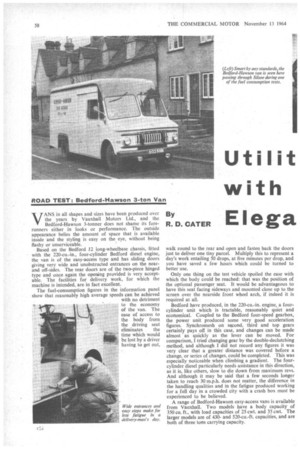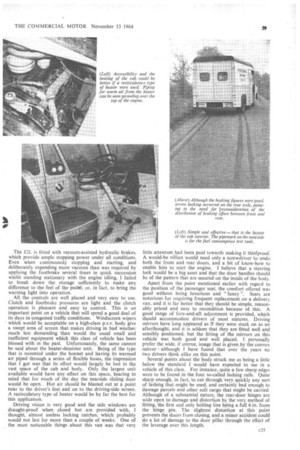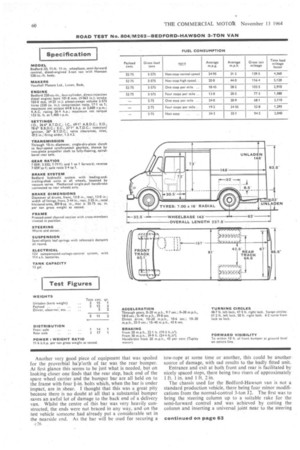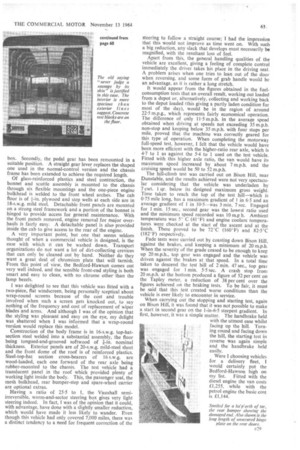Uti lit with Elega
Page 60

Page 61

Page 62

Page 65

If you've noticed an error in this article please click here to report it so we can fix it.
By R. D. CATER
VANS in all shapes and sizes have been produced over the years by Vauxhall Motors Ltd., and the Bedford-Hawson 3-tonner does not shame its forerunners either in looks or performance. The outside appearance belies the amount of space that is available inside and the styling is easy on the eye, without being flashy or unserviceable.
Based on the Bedford J2 long-wheelbase chassis, fitted with the 220-cu.-in., four-cylinder Bedford diesel engine, the van is of the easy-access type and has sliding doors giving very wide and unobstructed entrances on the nearand off-sides. The Tear doors are of the two-piece hinged type and once again the opening provided is very acceptable. The facilities for delivery work, for which the machine is intended, are in fact excellent.
The fuel-consumption figures in the information panel show that reasonably high average speeds can be achieved with no detriment to the economy of the van. The ease of access to the body from the .driving seat
eliminates the time which would be lost by a driver having to get out, walk round to the rear and open and fasten back the doors just to deliver one tiny parcel. Multiply this to represent a day's work entailing 50 drops, at five minutes per drop, and you have saved a few hours which could be turned to better use.
Only one thing on the test vehicle spoiled the ease with which the body could be reached: that was the position of the optional passenger seat. It would be advantageous to have this seat facing sideways and mounted close up to the screen over the nearside front wheel arch, if indeed it is required at all.
Bedford have produced, in the 220-cu.-in, engine, a fourcylinder unit which is tractable, reasonably quiet and economical. Coupled to the Bedford four-speed gearbox, the power unit produced some very good acceleration figures. Synchromesh on second, third and top gears certainly pays off in this case, and changes can be made almost as quickly as the lever can be moved. For comparison, I tried changing gear by the double-declutching method, and although I did not record any figures it was very clear that a greater distance was covered before a change, or series of changes, could be completed. This was especially noticeable when climbing a gradient. The fourcylinder diesel particularly needs assistance in this direction, as it is, like others, slow to die down from maximum revs. And although it may be said that a few seconds longer taken to reach 30 m.p.h. does not matter, the difference in the handling qualities and in the fatigue produced working for a full day in a crowded city with a crash box must be experienced to be believed.
A range of Bedford-Hawson easy-access vans is available from Vauxhall. Two models have a body capacity of 350 cu ft., with load capacities of 25 cwt. and 35 cwt. The larger models are of 430and 520-cu.-ft. capacities, and are both of three tons carrying capacity. The J2L is fitted with vacuum-assisted hydraulic brakes, which provide ample stopping power under all conditions. Even when continuously stopping and starting, and deliberately expending more vacuum than was required by applying the footbrake several times in quick succession whilst standing stationary with the engine idling, I failed to break down the storage sufficiently to make any difference to the feel of the pedal; or, in fact, to bring the warning light into operation.
All the controls are well placed and very easy to use. Clutch and footbrake pressures are light and the clutch operation is pleasant and easy to control. This is an important point on a vehicle that will spend a good deal of its days in congested traffic conditions. Windscreen wipers which would be acceptable on a high-class p.s.v. body give a swept area of screen that makes driving in bad weathei. much less demanding than would the usual small and inefficient equipment which this class of vehicle has been blessed with in the past. Unfortunately, the same cannot be said about the heater-demister unit. Being of the type that is mounted under the bonnet and having its warmed air piped through a series of flexible hoses, the impression that I got was that its effect would largely be lost in the vast space of the cab and body. Only the largest unit available would have any effect on this space, bearing in mind that for much of the day the nearside sliding door would be open. Hot air should be blasted out at a point near to the driver's feet and on to the driving-side screen. A recirculatory type of heater would be by far the best for this application.
Driving vision is very good and the side windows are draught-proof when dosed but are provided with, I thought, almost useless locking catches, which probably would not last for more than a couple of weeks. One of the most noticeable things about this van .was that very little attention had been paid towards making it thiefproof. A would-be villian would need only a screwdriver to undo both the front and rear doors, and a bit of know-how to enable him to start the engine. I believe that a steering lock would be a big asset and that the door handles should be of the pattern that are secured on the inside of the body.
Apart from the point mentioned earlier with regard to the position of the passenger seat, the comfort offered was good without being luxurious and "fancy ". Seats are notorious for requiring frequent replacement on a delivery van, and it is far better that they should be simple, reasonably priced and easy to recondition because of this. A good range of fore-and-aft adjustment is provided, which should accommodate drivers of most statures. Driving mirrors have long appeared as if they were stuck on as an afterthought, and it is seldom that they are fitted well and sensibly positioned, but the fitting of the mirrors on this vehicle was both good and well placed. I personally prefer the wide, if untrue, image that is given by the convex mirror—although I have found that over the years no two drivers think alike on this point.
Several points about the body struck me as being a little below the standard I would have expected to see in a vehicle of this class. For instance, quite a few sharp edges were to be found in the four so-called lashing rails. Quite sharp enough, in fact, to cut through very quickly any sort of lashing that might be used, and certainly bad enough to damage parcels and other soft cargo that might be carried. Although of a substantial nature, the rear-door hinges are wide open to damage and distortion by the very method of fitting, the first and only bolting line being a,full 6 in. from the hinge pin. The slightest distortion at this point prevents the doors from closing, and a minor accident could do a lot of damage to the door pillar through the effect of the leverage over this length. Another very good piece of equipment that was spoiled for the proverbial ha'p'orth of tar was the rear bumper. At first glance this seems to be just what is needed, but on looking closer one finds that the rear step, back end of the spare wheel carrier and the bumper bar are all held on to the frame with four 1-in, bolts which, when the bar is under impact, are in shear. I thought that this was a great pity because there is no doubt at all that a substantial bumper saves an awful lot of damage to the back end of a delivery van. Whilst the centre of this bar was very heavily constructed, the ends were not braced in any way, and on the test vehicle someone had already put a considerable set in the nearside end. As the bar will be used for securing a c26 tow-rope at some time or another, this could be another source of damage, with sad results to the badly fitted unit.
Entrance and exit at both front and rear is facilitated by nicely spaced steps, there being two risers of approximately 1 ft. 1 in. and 1 ft. 2111.
The chassis used for the Bedford-Hawson van is not a standard production vehicle, there being four minor modifications from the normal-control 3-ton 12. The first was to bring the steering column up to a suitable rake for the semi-forward control and was achieved by cutting the column and inserting a universal joint near to the steering box. Secondly, the pedal gear has been remounted in a suitable position. A straight gear lever replaces the shaped one used in the normal-control version and the chassis frame has been extended to achieve the required length.
Of glass-reinforced plastics and steel contruction, the bonnet and scuttle assembly is mounted to the chassis through six flexible mountings and the one-piece engine bulkhead is welded to the front wheel arches. The cab floor is of 1-in. plywood and step wells at each side are in 18-s.w.g. mild steel. Detachable front panels are mounted on a strong steel framework and a portion of the bonnet is hinged to provide access for general maintenance. With the front panels removed, engine removal for major overhauls is fairly easy. A detachable panel is also provided inside the cab to give access to the rear of the engine.
A very important point, but one that seems seldom thoughtof when a commercial vehicle is designed, is the ease with which it can be washed down. Transport organizations do not want a lot of dirt-collecting crevices that can only be cleaned out by hand. Neither do they want a great deal of chromium plate that will tarnish. From this point of view, the Bedford-Hawson comes out very well indeed, and the sensible front-end styling is both smart and easy to clean, with no chrome other than the lamp bezels.
I was delighted to see that this vehicle was fitted with a two-piece, flat windscreen, being personally sceptical about wrap-round screens because of the cost and trouble involved when such a screen gets knocked out, to say nothing of the frequency and cost of replacement of wiper blades and arms. And although I was of the opinion that the styling was pleasant and easy on the eye, my delight was shattered when I was informed that a wrap-round version would replace this model.
Construction of the body frame is in I 6-s.w.g. top-hatsection steel welded into a substantial assembly, the floor being tongued-and-grooved softwood of -1-in. nominal thickness. Exterior panels are of 20-s.w.g. mild-steel sheet and the front dome of the roof is of reinforced plastics. Steel-top-hat section cross-bearers of 16 s.w.g. are wood-loaded, each one forward of the rear axle being rubber-mounted to the chassis. The test vehicle had a translucent panel in the roof which provided plenty of working light inside the body. This, the passenger seat, the mesh bulkhead, rear bumper-step and spare-wheel carrier are optional extras. Having a ratio of 25-5 to 1, the Vauxhall semiirreversible, worm-and-sector steering box gives very light steering indeed. In fact, I was of the opinion that it could, with advantage, have done with a slightly smaller reduction, which would have made it less likely to wander. Even though this vehicle had only covered 7,000 miles, there was a distinct tendency to a need for frequent correction of the steering to follow a straight course; I had the impression that this would not improve as time went on. With such a big reduction, any slack that develops must necessarily be magnified, with the resultant loss of feel.
Apart from this, the general handling qualities of the vehicle are excellent, giving a feeling of complete control immediately the driver takes his place in the driving seat. A problem arises when one tries to lean out of the door when reversing, and some form of grab handle would be an advantage, as it is rather a long stretch.
It would appear from the figures obtained in the fuelconsumption tests that an overall result, working out loaded from a depot or, alternatively, collecting and working back to the depot loaded (this giving a partly laden condition for most of the day), would be in the region of around 22.5 m.p.g., which represents fairly economical operation. The difference of only 11-5 m.p.h. in the average speed obtained when driving at speeds not exceeding 35 m.p.h. non-stop and keeping below 35 m.p.h. with four stops per mile, proved that the machine was correctly geared for this type of operation. When completing the motorway full-speed test, however, I felt that the vehicle would have been more efficient with the higher-ratio rear axle, which is 4-7 to 1 as against the 5-4 to 1 used on the test vehicle. Fitted with this higher axle ratio, the van would have its maximum speed increased by about 7 m.p.h. and the cruising speed would be 50 to 52 m.p.h.
The hill-climb test was carried out on Bison Hill, near Dunstable, and the results achieved were not very spectacular considering that the vehicle was underladen by 7 cwt. 1 qr. below its designed maximum gross weight. Time taken to reach the top of the test hill—which is 0-75 mile long, has a maximum gradient of 1 in 6-5 and an average gradient of 1 in 10.5--was 3 min. 7 sec. Engaged for 1 min. 15 sec.. second gear was the lowest ratio used and the minimum speed recorded was 10 m.p h. Ambient temperature was 5° C (41°F) and engine coolant temperatures were checked at the start of the ascent and at the finish. These proved to be 72'C (160'F) and 82-5°C (182°F) respectively.
Fade tests were carried out by coasting down Bison Hill, against the brakes, and keeping a minimum of 20 m.p.h. When the severity of the grade ceased to be enough to keep up 20 m.p.h., top gear was engaged and the vehicle was driven against the brakes at that speed. In a total time taken to descend the test hill of 2 min. 47 sec., top gear was engaged for 1 min. 5-5 sec. A crash stop from 20 m.p.h. at the bottom produced a figure of 52 per cent on the Tapley meter, a reduction of 38 per cent over the figures achieved on the braking tests. To be fair, it must be said that this test created worse conditions than the vehicle is ever likely to encounter in service.
When carrying out the stopping and starting test, again on Bison Hill, it was found that it was not possible to make a start in second gear on the 1-in-6-5 steepest gradient. In first, however, it was a simple matter. The handbrake held with the utmost ease whilst facing up the hill. Turning round and facing down the hill, the starting test in reverse was again simple and the handbrake held easily.
Were I choosing vehicles for a delivery fleet, I would certainly put the Bedford-Hawson high on my list. Fitted with the diesel engine the van costs £1,255, while with the petrol engine the basic cost is £1,144.
























































































































